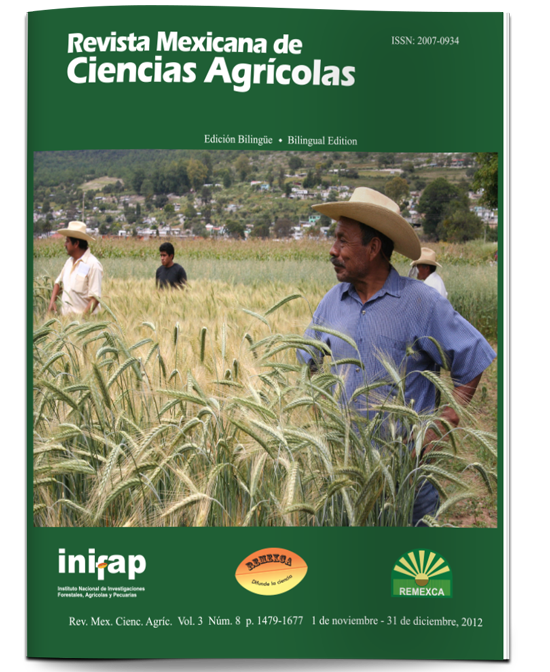Mechanical behavior of papaya fruits under axial compression
DOI:
https://doi.org/10.29312/remexca.v4i8.1135Keywords:
Carica papaya L., yield strength, biocedence point, breaking pointAbstract
The fruits of papaya (Carica papaya L.) are very susceptible to mechanical damage, which results in heavy losses in post-harvest. The aim of this study was to evaluate the mechanical behavior of papaya fruits in post-harvest, for which two experiments were conducted in the Experimental Field The Huasteca, INIFAP during the years 2011 and 2012. The variables evaluated were the strength and deformation required for the fruit to reach the elastic limit, biocedence and the breaking point. The compression was performed with a Instron Universal 4460. In the first experiment for ripening fruit treated with pre-harvest five combinations of fertilization, the treatment N-P-K- Cu-Zn, N-P-K-Ca-Zn, N-P-K-Fe-Zn reported increased resistance to force compression and was different to the treatment N-P-K-Mn-Zn (Tukey, p≤ .05). In the second experiment three cultivars were evaluated in two states of maturity, the fruits at physiological maturity were more resistant to attain the elastic limit (414 N) in relation to ripening (67 N), with statistical differences (Tukey, p≤ .05). The fruits of the hybrid PK 02 required more force to achieve the yield strength (298 N) with respect to the fruits of the variety Maradol roja (250 N) and the hybrid PK 03 (173 N), with differences (Tukey, p≤ .05). It is concluded that papaya fruits had different mechanical behavior depending on the nutritional management, the type of cultivar and maturity.
Downloads
Downloads
Published
How to Cite
Issue
Section
License
The authors who publish in Revista Mexicana de Ciencias Agrícolas accept the following conditions:
In accordance with copyright laws, Revista Mexicana de Ciencias Agrícolas recognizes and respects the authors’ moral right and ownership of property rights which will be transferred to the journal for dissemination in open access. Invariably, all the authors have to sign a letter of transfer of property rights and of originality of the article to Instituto Nacional de Investigaciones Forestales, Agrícolas y Pecuarias (INIFAP) [National Institute of Forestry, Agricultural and Livestock Research]. The author(s) must pay a fee for the reception of articles before proceeding to editorial review.
All the texts published by Revista Mexicana de Ciencias Agrícolas —with no exception— are distributed under a Creative Commons License Attribution-NonCommercial 4.0 International (CC BY-NC 4.0), which allows third parties to use the publication as long as the work’s authorship and its first publication in this journal are mentioned.
The author(s) can enter into independent and additional contractual agreements for the nonexclusive distribution of the version of the article published in Revista Mexicana de Ciencias Agrícolas (for example include it into an institutional repository or publish it in a book) as long as it is clearly and explicitly indicated that the work was published for the first time in Revista Mexicana de Ciencias Agrícolas.
For all the above, the authors shall send the Letter-transfer of Property Rights for the first publication duly filled in and signed by the author(s). This form must be sent as a PDF file to: revista_atm@yahoo.com.mx; cienciasagricola@inifap.gob.mx; remexca2017@gmail.
This work is licensed under a Creative Commons Attribution-Noncommercial 4.0 International license.



